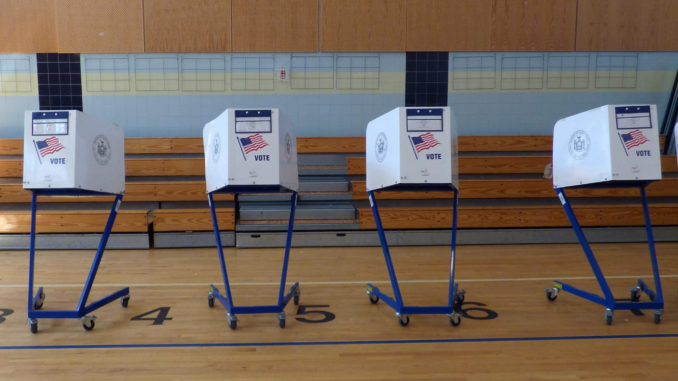
By Devin M
NYC-DSA drove Julia Salazar’s victory in NY State Senate District 18 and contributed meaningfully to the mobilizations for Cynthia Nixon’s and Jumaane Williams’ campaigns for governor and lieutenant governor. In all three, we drew on lessons learned in 2017.
Last year, NYC-DSA worked on two City Council campaigns: Khader El-Yateem’s run for Democratic nomination in Bay Ridge, and Jabari Brisport’s run on the Green Party ballot line in the general election in Crown Heights. DSA contributed around 1,000 positive IDs to each candidate, who each lost with around 30% of the vote in their respective races.
From Jabari’s campaign, we learned the limitations of running a third-party candidate in New York State, even when they campaign on a hot local issue, like the redevelopment of the Bedford Union Armory. From Khader’s campaign, we learned the limitations of running a completely independent field operation: We weren’t a part of the campaign’s leadership or the group making strategy decisions. Our strategy in Alexandria Ocasio-Cortez’s Congressional campaign was essentially a variation on our strategy in Khader’s campaign: DSA organized an independent field operation, but with members on the campaign staff, we had more influence.
Owning the Campaign in North Brooklyn
The Brooklyn Electoral Working Group was hungry for a race we could own. We wanted to recruit our own candidate to run in a district of our choosing, set the policy platform, and have complete autonomy over field operations. So we recruited Julia, and she hired two members of the Electoral Working Group, Tascha Van Auken and Michael Kinnucan, as campaign manager and deputy manager, respectively. Later, she also hired a non-member as a volunteer organizer. The rest of the working group’s Organizing Committee played a large role in all aspects of the campaign’s field operations: training field leads, setting the target universe, recruiting volunteers and collecting data.
Over the course of the campaign, DSA led a network of nearly 2,000 volunteers in SD 18, nearly half of them DSA members. Those volunteers knocked on more than 120,000 doors, spoke with over 10,000 voters, and ID-ed close to 8,000 supporters. What’s more, we increased turnout by over 250% compared to the primary election in 2014. That increase far exceeds the average increase for the city and state, as well as the turnout jumps in the similar State Senate districts that had contested elections in both 2018 and 2014.

Leveraging Strengths for Statewide Campaign
With the Cynthia Nixon and Jumaane Williams endorsements, we took a different approach. DSA contributed to their statewide campaigns by leveraging our existing organizing campaigns. In Senate District 18, we distributed literature and identified voters for Cynthia and Jumaane, as we campaigned for Julia. City-wide, we modified ongoing campaigns for the New York Health Act and Universal Rent Control to generate positive IDs for both candidates. In total, NYC-DSA identified more than 1,000 supporters of Cynthia and Jumaane. Furthermore, Cynthia received more votes in North Brooklyn than in any other part of New York City.
NYC-DSA also had meaningful input on issues. To gain our endorsement, Jumaane agreed to return all money he had received from corporations and real estate firms. After our endorsement, Cynthia agreed to adopt, more or less whole, the labor policy platform that NYC-DSA’s labor branch proposed. The latter injected a much needed voice into the regional discourse on the subject of organized labor, forcing many regressive forces, both within the labor community and City Hall, to show their true colors on this subject.
Making Connections
Both Julia’s campaign and the two statewide campaigns also gave us a great opportunity to work more closely with other organizations, most importantly Make The Road, New York Communities for Change, and the Working Families Party. Make The Road and NY Communities for Change both canvassed for Julia and provided visibility at many priority poll sites on election day. The Working Families Party provided valuable communications advice, and paid for our usage of their auto-dialing tool. Until then, we did not have a way to phonebank voters effectively.
Lastly, at weekly campaign barbecues, DSA members mingled with members of the other groups and individuals who found Julia’s campaign over social media. We expect that socializing to pay off in continued collaboration and in new DSA members. As of Election Day, 42% of Salazar volunteers were dues-paying DSA members, and 51% had emails matching to our city-wide list, likely due to attending a DSA meeting at some point. We hope that this number will continue to increase as we bring more of these people into the Electoral Working Group and get them plugged into all of the other great work DSA is doing across the city.
In the coming weeks the Brooklyn Electoral Working Group will be putting together a more formal analysis of the Salazar campaign. We’ll also have a more in-depth look at performance trends when we get voter-level data later this year.
To learn more about these campaigns or the Brooklyn Electoral Working Group, come to the next WG meeting on Thursday October 4th at Mayday Space.
